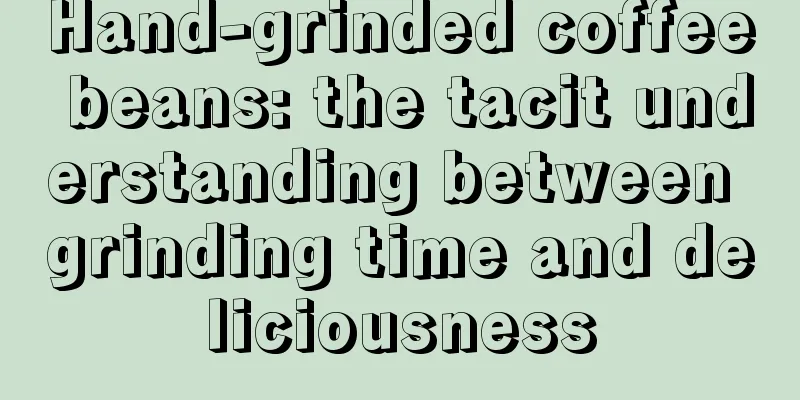Can I brew the ground coffee beans directly?

The relationship between coffee bean grinding fineness and coffee flavorThe process of grinding coffee beans is one of the key steps in making high-quality coffee. When grinding, coffee beans are ground into different particle sizes, and this fineness directly affects the flavor and extraction effect of the coffee. Generally speaking, the grinding process of coffee beans can be divided into three different finenesses: coarse grinding, medium grinding and fine grinding. Coarse grinding is suitable for using a French press pot, which can provide a more balanced extraction effect, while fine grinding is more suitable for espresso machines or Italian coffee machines, which can produce a richer coffee taste. Different grind sizes affect the speed and efficiency of coffee extraction. Coarser coffee powder will result in incomplete extraction, making the coffee taste bland; while too fine a powder may result in over-extraction, making the coffee taste bitter. In order to achieve the best flavor balance, it is necessary to choose the right grind size according to the coffee machine or brewing device used. For example, drip coffee machines usually use medium-coarse coffee powder to ensure even extraction. In addition, the freshness of the ground coffee also affects the flavor of the coffee. Freshly ground coffee can better preserve the aroma and taste of coffee beans, while coffee grounds that have been stored for a long time may lose their rich flavor. Therefore, it is recommended to grind coffee beans before brewing each time to get the best flavor experience. Effects and challenges of brewing directly with water after grindingIt may seem simple to brew coffee beans directly with water after grinding them, but the actual effect is often disappointing. First of all, the fineness of the grind has a significant impact on the brewing effect. If the grind is too fine, brewing directly may lead to over-extraction, making the coffee taste bitter and unpleasant. The surface area of fine powder is large, which is easy to release too many bitter substances, and these substances are difficult to be evenly extracted by water in a short time. In addition, ground coffee is prone to uneven extraction when brewed directly. The contact time and method between coffee powder and water are different from those of traditional coffee machines or utensils, which often leads to over-extraction in some areas and under-extraction in others, affecting the overall flavor. In order to improve the brewing effect, it is recommended to use special coffee utensils to control the extraction process. Through the correct brewing method, such as controlling the water temperature and water filling speed, the taste of the coffee can be better balanced and the above problems can be avoided. If conditions permit, using a filter or other filter to remove coffee grounds is also an effective way to improve the drinking experience. The effect of grinding coarseness on coffee taste and concentrationThe coarseness of the grind directly determines the taste and strength of the coffee. Coarse grinds have larger particles and are usually used in French presses. Coarse grinds extract more slowly, which helps prevent over-extraction and usually retains more of the original flavor of the coffee, making the coffee taste rounder and richer. It is suitable for brewing methods that require longer steeping times, such as French presses and cold brew coffee. Medium grind coffee powder is suitable for drip coffee machines or pour-over coffee machines. This grind fineness provides a balanced extraction effect, making the coffee neither too weak nor too strong. Medium grind powder can release the flavor of coffee in a shorter time, making the coffee taste clear and layered. Fine ground coffee has smaller particles and is often used in espresso machines. Fine ground coffee has a larger contact area with water, which can quickly release the rich flavor of the coffee, making it ideal for fast-brewing coffee machines. When using fine ground coffee, special care must be taken to avoid over-extraction, otherwise the coffee may become too bitter. Each grind size corresponds to a different brewing method, so choosing the right grind size is crucial to getting the ideal coffee flavor. Understanding and using the characteristics of these grind sizes can help coffee lovers make coffee that better suits their taste. Best Practices and Techniques for Optimizing Coffee BrewingIn order to make a delicious cup of coffee, it is important to choose the right brewing method and master some key skills. First, it is important to understand the characteristics and adjust the grind size when using different coffee machines or brewing utensils. For example, a French press is suitable for coarse ground coffee powder, while a drip coffee machine requires a medium grind powder. The correct grind size can ensure uniform extraction and avoid problems with over-extraction or uneven taste. Secondly, controlling water temperature is another key factor in improving coffee quality. Generally speaking, the best brewing water temperature for coffee is between 90 and 96 degrees Celsius. Too high a water temperature may cause bitterness, while too low a water temperature may cause the coffee to taste weak. Therefore, using a thermometer or relying on experience to master the right water temperature can significantly improve the flavor of the coffee. In addition, brewing time is also an important factor that affects the taste of coffee. Different brewing methods require different times. For example, espresso is usually ready in 25 to 30 seconds, while a French press pot requires 4 to 5 minutes of steeping time. Adjusting the brewing time according to the utensil used and the fineness of the grind can help achieve the ideal flavor and strength. Finally, regular cleaning of coffee utensils should not be neglected. Residual coffee oils and coffee grounds may affect the taste of coffee. Regular cleaning and maintenance of coffee machines or utensils can ensure that every brewed coffee maintains the best flavor. Avoiding common coffee-making mistakes: practical adviceThere are some common misconceptions in the coffee bean grinding and brewing process that may affect the flavor of the coffee. First, many people ignore the impact of the grind fineness on the quality of the coffee. Using an inappropriate grind fineness will lead to uneven extraction of the coffee, resulting in a bad taste. It is recommended to adjust the grind fineness according to the coffee maker used, for example, a French press uses a coarse grind, while an espresso machine requires a fine grind. Another common mistake is improper water temperature control. Using water that is too hot or too cold can cause the coffee to taste too bitter or weak. The ideal water temperature range is 90 to 96 degrees Celsius, and the best way to control the water temperature is to use a thermometer to ensure that the water temperature is stable within the appropriate range every time you brew. In addition, brewing time is also critical. Different brewing methods require different times. Too short or too long a brewing time will affect the taste of the coffee. Knowing the best time for each brewing method and adjusting it according to personal taste can get the ideal coffee flavor. Finally, cleaning your coffee equipment is often overlooked, but it has a significant impact on the flavor of your coffee. Residues of coffee oils and coffee grounds can affect the quality of each brew. Regularly cleaning your coffee machine and equipment can maintain the pure taste of your coffee and ensure that every cup of coffee can show its best flavor. |
<<: What do you need to prepare to grind your own coffee beans?
>>: How long can you keep ground coffee beans?
Recommend
Finding authentic and delicious coffee beans: brand recommendations
Finding the most delicious coffee beans Coffee is...
Coffee beans taste secrets: taste the aroma and richness from around the world
The secret of coffee beans' taste Coffee is o...
Paradise Estate in Colombia: The Ultimate Enjoyment of Coffee Beans
Paradise Estate in Colombia: The Ultimate Enjoyme...
Where are coffee beans produced?
Overview of global coffee bean producing areas: t...
How to choose coffee beans: Focus on reducing acidity
Choosing coffee beans is a task that requires con...
I want to learn to be a barista, where can I learn in Dalian?
If you want to learn to become a barista, Dalian ...
The art of coffee bean tasting, exploring the secrets of quality and excellence
The art of coffee bean tasting is a science of ex...
Best coffee beans for energy
Coffee beans for energy Coffee is a must-have dri...
Reliving the coffee candies of childhood, those sweet memories like buttons
Revisiting the coffee candies of childhood, those...
Are coffee beans pooped out by the coffee cat?
Coffee Bean Basics: The Journey from Plant to Cup...
Selecting the heart of espresso coffee beans
Selecting the heart of espresso coffee beans Ital...
Uncover the secrets of global coffee brands and taste the essence of coffee from around the world
Abstract: This article will reveal the secrets of...
How to successfully promote a coffee shop
introduction Opening a coffee shop is a challengi...
Coffee bean brand recommendation: choose the coffee beans that suit you best
Coffee bean brand recommendation: Choose the best...
Coffee bean processing after grinding: innovative solutions to improve coffee quality
introduction Coffee is a widely loved drink aroun...









